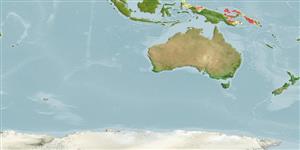>
Gobiiformes (Gobies) >
Gobiidae (Gobies) > Gobiinae
Etymology: Eviota: No etymology given, suggested by Christopher Scharpt: from Latin 'eu' for 'true' and 'iota' for anything very small, in combination 'truly very small' referring to it as being the smallest vertebrate at the time it has benn described by Jenkins (thus, making the suggestion by Scharpt plausible.; brahmi: Named for Brahm Kai Erdmann, who recognized that the species had been incorrectly identified as E. nigriventris in literature; a noun in the Latin genitive case..
Environment: milieu / climate zone / depth range / distribution range
экология
морской ассоциированный с рифами; пределы глубины 0 - 20 m (Ref. 95677). Tropical
Western Pacific: Papua New Guinea.
Size / Вес / Возраст
Maturity: Lm ? range ? - ? cm
Max length : 1.7 cm SL самец/пол неопределен; (Ref. 95677); 1.5 cm SL (female)
Краткое описание
морфология | морфометрия
колючие лучи спинного плавника (общее число): 7; членистые (мягкие) лучи спинного плавника (общее число): 9-11; колючие лучи анального плавника 1; членистые (мягкие) лучи анального плавника: 8 - 10. This species is distinguished from its congeners by the following characters: entire lower body with a red stripe, from the eye back to caudal-fin base where it grades into black ending in a dorsally asymmetrical spot that angles sharply towards the ventral portion of the caudal fin; pectoral-fin base with line of small black dots extending down to its base, the upper half are larger and more intense, the ones on the lower half smaller, less intense, and expanded across lower part of the base; cephalic sensory pore system lacking the PITO and IT pores and the AITO pore is enlarged; usually 10/9 dorsal/anal fin-ray formula; simple pectoral-fin rays; in both sexes the spinous dorsal-fin elongate or filamentous; genital papilla nonfimbriate. In life, the ventral red stripe is bordered dorsally by a bright white stripe that runs from the top of the head back to the caudal fin where it curves down following the angled black spot; the eye without a narrow white line on the iris above the pupil; a wide white line extends up the interorbital area, the width of the line extending from eye to eye (Ref. 95677).
Life cycle and mating behavior
половая зрелость | размножение | нерест | икра | Fecundity | личинки
Greenfield, D.W. and L. Tornabene, 2014. Eviota brahmi n. sp. From Papua New Guinea, with redescription of Eviota nigriventris (Teleostei: Gobiidae). Zootaxa 3793(1):133-146. (Ref. 95677)
Статус Красного Списка МСОП (Ref. 130435)
Угроза для людей
Harmless
Использование человеком
дополнительная информация
народные названиясинонимыобмен веществхищникиэкотоксикологияразмножениеполовая зрелостьнерестSpawning aggregationFecundityикраРазвитие икры
Возраст/РазмерыростЗависимость между длиной и массой телаЗависимость между длинамиРазмерный составморфометрияморфологияличинкидинамика численности личинокпополнениечисленностьBRUVS
ссылкиаквакультура (рыбоводство)особенности рыбоводствастепень растяжениягенетикаElectrophoresesнаследуемостьболезниобработкаNutrientsMass conversion
соавторыизображенияStamps, Coins Misc.звукиCiguateraскоростьтип плаванияжаберная областьOtolithsмозгзрение
инструменты
Специальные отчеты
Скачать в формате XML
ресурсы в Интернет
Estimates based on models
Preferred temperature (Ref.
123201): 28.7 - 29.4, mean 29 °C (based on 194 cells).
Phylogenetic diversity index (Ref.
82804): PD
50 = 0.5000 [Uniqueness, from 0.5 = low to 2.0 = high].
Bayesian length-weight: a=0.00708 (0.00333 - 0.01504), b=3.09 (2.92 - 3.26), in cm total length, based on LWR estimates for this (Sub)family-body shape (Ref.
93245).
Trophic level (Ref.
69278): 3.0 ±0.3 se; based on size and trophs of closest relatives
устойчивость к внешним воздействиям (Ref.
120179): высокий, минимальное время удвоения популяции до 15 месяцев (Preliminary K or Fecundity.).
Fishing Vulnerability (Ref.
59153): Low vulnerability (10 of 100).
